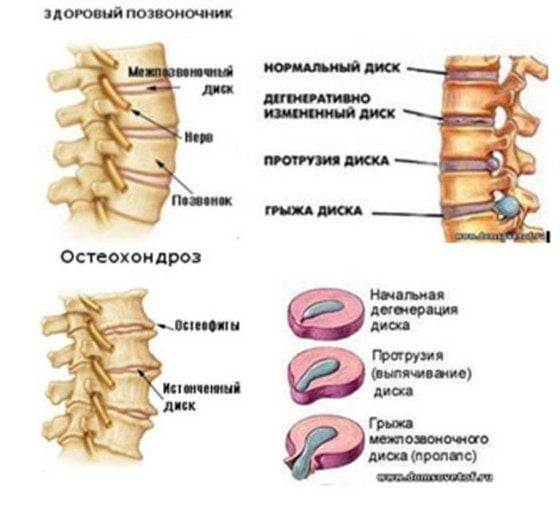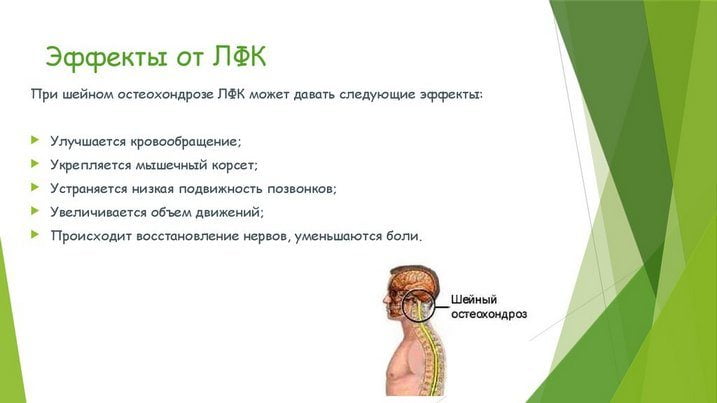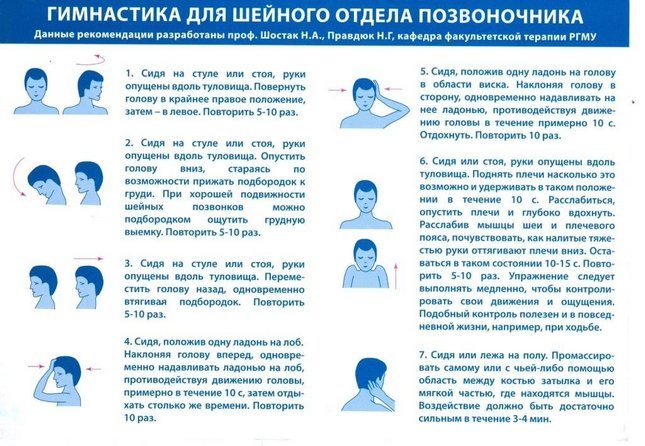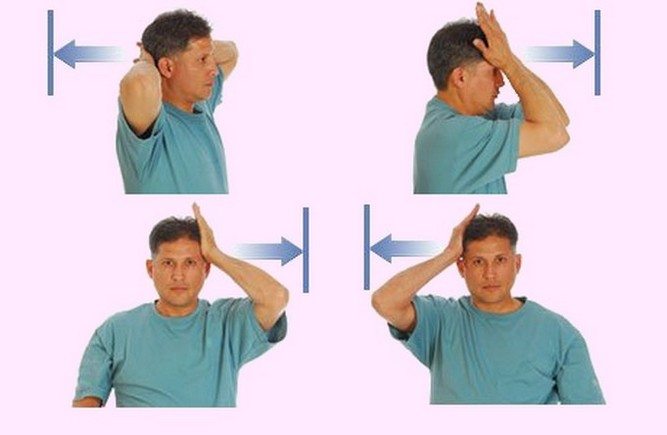Exercise therapy for osteochondrosis of the cervical spine: recommendations for exercises, contraindications for performance
Osteochondrosis is a common disease of the spine of a degenerative nature, characterized by deformation of the cartilaginous discs of the vertebrae and a change in the structure of their bone tissue. In the modern world, they appear after 30 years, in any category of the population. The most commonly diagnosed osteochondrosis of the cervical and lumbar segments of the spine. It is necessary to treat this pathology in a complex, using medical methods, massages, reflexology. Exercise therapy for osteochondrosis of the cervical spine is an effective method of restoring the functions of this organ, by stimulating blood circulation in the cartilage, restoring muscle elasticity and increasing overall tone.
Introduction

Symptoms of osteochondrosis are caused by dysfunction of the vertebrae, in particular, this is a limitation of movement, muscle spasms and back pain, there are also a number of symptoms that occur when the roots of the spinal nerves are compressed by pathologically altered vertebrae.
It manifests itself in the form of pain in the neck, in the region of the heart, chest, intercostal muscles, in the arms and shoulders. There are dizziness, movement restrictions, numbness in the limbs.
Exercise therapy reduces the severity of symptoms and allows patients to improve their general condition.
Recommendations for exercise therapy and contraindications for its implementation
Therapeutic physical education implies some preparation, together with an instructor, who in the future must control the correct implementation of a set of exercises.
The program of sessions and a set of physical therapy exercises for the spine are agreed with the doctor.
- Exercise should be done in a well-ventilated area.
- Clothing should be comfortable and not restrict movement.
- You should do it no earlier than 30 minutes after eating.
- Physical therapy exercises alternate with exercises for proper breathing.
- Increasing the load and intensity of exercise should be done gradually. An overreaction from the heart suggests stopping exercise and contacting a doctor.
- Painful phenomena in the process of execution suggest a replacement for stretching and relaxation exercises.
- It is necessary to control the pulse.

Therapeutic exercise for osteochondrosis of the cervical region has contraindications:
- It is impossible to practice during acute manifestations of osteochondrosis of the spine, when pain is expressed both during movement and at rest.
- Dizziness due to impaired circulation caused by instability of the vertebrae is also a contraindication to exercise therapy.
- The presence of acute diseases of an infectious and non-infectious nature, accompanied by signs of inflammation, and exacerbations of chronic processes excludes exercises, as well as a severe degree of chronic pathologies.
- Oncological diseases, at any stage, in order to avoid stimulation of tumor growth.
- Conditions associated with impaired blood clotting, such as thrombosis and a tendency to bleed.
- Arterial hypertension and cardiovascular problems in the stage of decompensation.
- Poisoning.
- Myopia of a high degree, with the addition of pathologies from the fundus.

You can not perform exercises with diseases of the cardiovascular system
Indications and contraindications for exercise therapy for osteochondrosis of the cervical spine in each case are individual, and should be determined by neurologists and doctors, after appropriate diagnosis.
- You can not exercise, overcoming pain.
- It is better to skip exercises that cannot be done for one reason or another.
- All movements must be performed without sudden jerks, smoothly.
- The regularity of classes is at least 4 times a week.
What not to do
With osteochondrosis of the spine, it is impossible to perform weightlifting exercises, lift weights, run, jump, swing and push - this gives undesirable physical stress on the spine. Exercises with an emphasis on hands and hanging are also excluded, it is worth using the equipment for gymnastics carefully.
If the patient was already involved in sports before the disease, then, in agreement with the doctor, you can leave his training program, removing only dangerous exercises.
Exercise therapy for cervical osteochondrosis - exercises
What set of exercises can you do?
neck girth
The exercise is done standing or sitting. The hands act as a collar lock. With the girth of the neck, the thumbs should be under the edge of the lower jaw in front, and the rest remain behind, with placement under the occipital region. In this position, the neck tilts to the right and left, slowly, with a delay on the side of the tilt for 2 seconds. Then the arms are slightly lowered and neck tilts are again made.
Hand-supported squats
Performed standing, leaning on the tabletop with palms, turning his back to the table. Slightly throwing back your head, you need to stretch your body up, stop for 2 seconds, which will give the necessary stretch. After that, you need to sit down, still resting on your hands, at a level comfortable for the body, tilting your head down. This relieves tension from the neck muscles.

book on head
It is performed sitting on a chair, the posture is straight. A hardcover book is placed on the head so that it does not move out. This state should be fixed for 5 minutes, or less if it becomes uncomfortable. The exercise returns the cervical vertebrae to the physiological position.
Neck flexion with head resistance
It is carried out sitting on a chair or standing, with a straight posture. The palm is placed on the forehead and presses on the head, which resists without moving back. Runs for 20 seconds. Further, the head is thrown back and the second hand is placed under the occipital region. Hands begin to press on the head at the same time, its resistance remains the same. Runs for 5 seconds. There are no noticeable pain phenomena in the norm. Exercise relieves tension from the neck muscles and stretches them.

Neck extension with head resistance
It is also done while sitting on a chair or standing, with a straight posture, one palm is placed on the back of the head, exerting pressure, and the head must resist this. It is performed for no more than 20 seconds, after which the palm still presses on the occipital region, the head tilts. In this state, you need to stay for 5 seconds, there should be no pain. This exercise stretches the muscles and vertebrae of the neck.
Neck tilts
It is carried out in the same position, only the hand is located on the side of the head and slightly presses on it. It is necessary to resist the pressure, remaining in this state for 20 seconds. Further, the second hand is placed under the head, the head leans towards the hand. Hands press each on its own side, 5 seconds. Repeat with a change of hands. Painful phenomena should not be, it is necessary to monitor well-being.

Simultaneous rotation of the head and neck
It is carried out standing or sitting on a chair, with a straight posture. The palm is placed on the side of the face, to the chin and lower jaw, putting pressure on this place. The teeth should be squeezed tightly, the hand should not be pressed very hard. The head resists the pressure. Hold the position for about 20 seconds, then repeat. After that, the second palm is placed on the back of the head from the side, the chin rises and the head turns towards the hand located on the back of the head. This position is maintained for 5 seconds, then the hands change and the action is repeated. Exercise pulls the muscles of the back of the head and neck, normally painless.
Additionally, you can perform a few more exercises:
- Sitting on a chair, place the lower parts of the palms on the temples. When inhaling, the teeth close and the muscles at the temples tense. The skin of the temporal region is stretched upward with the hands. When you exhale, the tension stops and the skin is released. Repeat also, with a slight shift of the palms up about 5 times.
- Also, sitting on a chair evenly, palms should be pressed to the cheekbones, slightly press the temples with the tips of spread fingers. With a little pressure, the fingers slide up and down, the head tilts back and forth. The fingers in the process reach the top of the head. The exercise is repeated no more than 5 times. It relaxes the muscles in the temples and improves blood flow, removing pain.
- Sitting on a chair or standing with a straight neck and back, both hands are placed on the back of the neck, fingers overlap or cross. In this position, movements are made according to the type of sliding along the neck. At the same time, the head and neck bend. You need to repeat no more than 5 times.
- In the same position, the palms are placed on the back of the head, with light pressure, the head resists. After that, one hand is placed on the side of the neck so that its fingers reach the 7th vertebra (a protruding tubercle at the base of the neck). Sliding movements are made, the neck and head lean back and forth. Hands change and the exercise is repeated.
If physical therapy for osteochondrosis of the cervical spine is performed correctly and regularly, then a set of exercises relieves tension, stimulates blood flow, strengthens the muscles of the neck, improves the mobility of the vertebrae, thereby expanding the range of motion, as a result, inflammation is removed from the nerve roots and the pain subsides.














